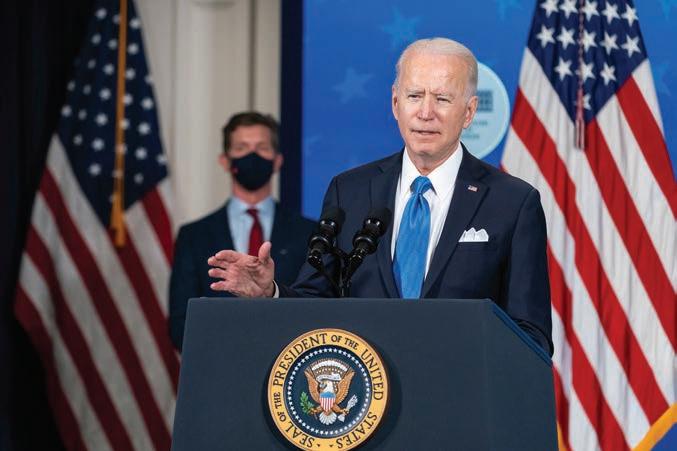
12 minute read
Opinion
A glimmer, and it sure feels nice
Ayear later. We’re still mourning the deaths and illnesses, optimistic that we can finally see to the other side, that the the disruption of life as we knew it, the months of gut- tide is turning, that this weird interlude in our time here on wrenching unknowns causing unfamiliar anxiety. It was this planet is finally being beaten back one day at a time. March 17, 2020, when Gov. Roy Cooper began shutting down Medical and public health professionals are warning us, wisebusinesses and most of us waited for the tsunami that we ly, not to let down our guards. But hope and optimism are could see — or at least imagine — in the distance without part of my DNA, so I can’t help having any idea how horrific its final toll, when the worst of it myself. would come, when it would finally recede, and who or what We all react differently to a crisis. would be left standing. Even in the early days of the pandemI’ve always been confident in my ability to take care of myself and those close to me, those who matter. My upbringing was lean, so I grew up figuring out how to scrap, how to survive and will your way to the other side when you couldn’t always see the path. So, the year of Covid, especially back last spring and early summer, I — like many others — was on shaky ground. No matter my toughness or my abilities or my Scott McLeod Editor ic, I remained confident that researchers would tame the virus. I’m not a science guy, but I’ve read articles and books over the last few years on the advances in DNA structuring, genome editing, CRISPR technology and RNA sequencing and such. Surely planning, things were out of my control. That’s frightening. we could quickly develop a vaccine if
We were laying off employees, people who were my we dedicated the resources. These biological breakthroughs friends. I feared the business I had started and nurtured for coupled with supercomputers have changed with way we can 20 years could, perhaps, go under. I wasn’t sure how my attack medical problems. children would get through all this, my in-laws who are More worrisome was whether politicians could cope with healthy but in their 80s, hell, even if my wife Lori and I the economic issues that came with the shutdowns. This is would be safe. from a column I wrote on March 17, 2020:
But here we are, and despite the human toll — 535,000 It’s a frightening future when hard-working people all over U.S. citizens dead, 2.66 million worldwide — most of us are the country are having to count on politicians to get them through a hard time. We’ve often heard people accuse them — the politicians — of not knowing anything about Main Street and how it works. As I look down the road and see at least four to eight weeks of shutdowns and definite slowdowns, I’m hoping we’re wrong.
I’m hoping those leaders in Washington, D.C., and Raleigh get this right and provide help not only to the large industries owned by their fat-cat donors, but to the workers soon to lose their jobs and the small entrepreneurs who employ those workers and who are the bedrock of this economy.
Largely, politicians did what was needed. They upped unemployment benefits, didn’t penalize businesses for laying people off, provided loans and grants on great terms to businesses large and small, provided direct payments to most taxpayers, demanded landlords not evict tenants for non-payment, gave young workers a break on paying down their student loans, and more.
We can argue about the details of these aid packages and whether they adhere to one’s conservative or liberal ideology, but many small businesses — like ours — have made it through this tough year when things originally looked dismal. When the GOP was in control, needed measures were passed; when the Democrats took control, needed measures were passed.
The future is always uncertain. But, a year ago most of us couldn’t see the light at the end of the tunnel. Now a glimmer, and it sure feels nice.
(Scott McLeod can be reached at info@smokymountainnews.com)
Another view on childhood poverty
To the Editor:
In last week’s edition of The Smoky Mountain News the editor gave us his thoughts of the bill in Congress to address childhood poverty by giving middle-income and low-income families $300 or $250 per child per month (until the child reaches 18 years of age in the original plan). Since then Congress passed the bill with a modified plan that will increase the child tax credit from what it is currently but the plan will terminate after one year. The editor is a supporter of the increased child tax credit plan and the continuation of it indefinitely.
I disagree with his position on the overall effects this plan to address childhood poverty. I am not an expert on this subject but there are many groups and organizations that do study it full time and whose opinions and positions we should embrace. One of them is the American Enterprise Institute (AEI), whose poverty studies group produces a free biweekly email newsletter on the subject with not only their conclusions but also those of other experts in the field of poverty in this country. I encourage SMN readers to subscribe to that newsletter. It will give you a new appreciation for the complexities of poverty and the unintended consequences of antipoverty government programs. They also occasionally include articles about attempts to measure poverty more accurately called Supplemental Poverty Measure and Consumption Poverty. SMN Editor Scott McLeod provides us the statistics on poverty which is strictly based on a measurement of the household income. He questions how a family of four can “make it work” on $504 per week which is the poverty threshold. He fails to mention what’s called the poverty safety net of existing government programs that effectively raises the family “income” substantially. These include: EITC (Earned Income Tax Credits), SNAP for food, TANF for temporary cash assistance, HUD housing assistance programs, Pell Grants to help pay for college costs, Child Nutrition pays for school breakfast and lunch, LIHEAP – Low Income Home Energy Assistance Program, and 6 others for a total of 13 programs plus Medicaid. The obvious point is that the real income of families utilizing these programs is much higher than their income from their employment. Plus, there are state programs and local charities. Taxpayers can take some comfort in knowing that the 13 federal programs plus Medicaid cost approximately $827 billion in fiscal year 2020 per the federalsafetynet.com website. Our commitment to addressing poverty through these federal programs is substantial and a positive reflection of our compassion as a society for our neighbors in need.
In the column we also learned that 93 percent of U.S. children will receive a benefit under the plan. Wow. So we have a federal government that is $XX trillions in debt and the plan is to add to it by giving cash to middleincome families even though many of them may disagree with unnecessary government spending? And just who would receive the cash? The parents of course. Would they use it for the children? Is it possible that the cash payments to families will result in some parents choosing to stop working or work less?
We have a substantial safety net now for low-income families. And it has been working. U.S. census data shows that before the pandemic the poverty rate was the lowest in history, down from 14.8 percent in 2014 to 10.5 percent in 2019. We don’t need payments to families from the government based on the number of children they have. Instead, our federal government needs to make revisions in the tax code to decrease marginal effective tax rates for low-income workers, reduce tax rates for families, and eliminate marriage penalties in the tax code. At the local and state level our efforts must be focused on employing our able-bodied (and able-minded) neighbors who currently are in poverty. Over the past 60 years we have learned (those who study poverty tell us) the most effective way to decrease child poverty is through jobs and employment of their parents, not government cash programs. John Johnson Lake Junaluska
LETTERS
Let’s do away with Electoral College
To the Editor:
In the recent election Joe Biden received a majority of 7.1 million popular votes and 74 Electoral College votes. With this overwhelming number of votes, he could have lost the election if his opponent had received 270 of the 538 total electoral votes. With only a 65,000-vote swing from the 7.1 million majority this could have happened. Five times in history presidential candidates have won the popular vote and lost the Electoral College.
With the four-year period between presidential elections and the absence of printed matter people have limited knowledge of the Electoral College. Very few people are aware there was a strong affiliation between the Electoral College and slavery.
In 1787 selected state delegates convened in Philadelphia for a Constitutional Convention. The greatest challenge facing them was approving a system for electing presidents. Many of them were opposed to Congress being involved and also opposed to electing by popular vote. Dissension arose to the Electoral College idea because slaves, who couldn’t vote, would be counted in the tally of the overall population of the states. This count would determine the number of electors voting for a presidential candidate. Eventually, there was a compromise that enslaved blacks would count as three-fifths of a person when the population count was tabulated. With this, the Electoral College was ratified by the delegates.
It appears that the strong resistance to electing a president by popular vote was the power they could attain by excessive support of the people.
At the time of the Constitutional Convention in 1787 political parties didn’t exist. As these parties evolved, power was divided on a more equal basis. As this came about and after the Civil War the Electoral College should have been abolished and election of the president by popular vote enacted into law. When I vote I want my vote to be counted in the overall total and not killed by an electoral vote.
A modest proposal for reviving Ghost Town in the Sky
BY CASE BROWN GUEST COLUMNIST
The on-and-off again investment deals for the embattled Ghost Town amusement park are familiar to anyone who reads these pages. Multiple meandering deals and their abrupt course corrections feel remarkably like the Black Widow ride that used to jerkily sling mountain ilk around to the soothing sounds of raging death metal picked by the latest pimpled carnie operator. Puke-inducing memories aside, I have a modest proposal for the beleaguered beast atop Maggie’s Buck Mountain. We have the unique opportunity here to increase renewable energy storage and resolve the overtourism problem burgeoning in the mountain region.
It’s called “Mountain Gravity Energy Storage.” Now, hold your disbelief for a minute and hear me out …
The oft-mentioned drawback with renewable energy is that the sun only shines during the day and wind only blows intermittently. The production of clean energy must be paired with some type of energy storage to make the whole system viable. Batteries are expensive, decay over time, and unfortunately drag with them a whole host of environmental impacts from rare earth minerals mining to toxic manufacturing and waste disposal. But a battery need not be based on electro-chemical energy. Batteries can use any type of energy that can be stably stored and reliably released. Gravity just happens to be the type of energy that exerts force all the time. It does so with brutal consistency — as all you weekend-warrior hikers will grumpily attest.
Here comes the pitch about Ghost Town in the Sky …
With a little mountain ingenuity, that grand chairlift and funicular train could carry heavy loads from the valley floor to the top of the mountain during surplus energy-generating hours (i.e., sunny/windy days). These “loads” could be stored at Ghost Town for variable periods of time. When the sunsets are over and the winds die down, gravity bestows upon us the gift of free energy. The “loads” come down off the mountain during these low energy periods, using their weight and the 1,250 feet of steep, mountainous decline to turn a massive turbine which generates electricity.
I can’t see the need to come up with some cockamamie scheme to carry heavy rocks, everybody’s unused kettle bells, or superfluous chainsaw bear sculptures up the mountain. The infrastructure is already perfectly suited to carry unsuspecting tourists and overstaying guests up that vertiginous incline. In fact, you might say it was specially designed to do that very thing. I think the engineering specs may have even adjusted for the lost weight from puke, dropped phones/flip-flops, and failed romances that accrue from the nauseating ascent.
I can hear the snickering and the scoffs, but I am dead serious. Think about the unique convergences. Solar works best in the bright sun which coincides precisely when tourists clog the overloaded intersections, trailheads and overlooks all around this scenic county. The excess of navigationinept, mountain-road-ignoring visitors could easily be stored atop the mountain during the daylight hours.
Why not go for a twofer? Ghost Town used to offer rides for the wild “younginz” while still providing some music/street theater entertainment for the mature crowd in one ticket. Let’s update that double feature with an energy storage system that concentrates view-seeking tourists off the roads at peak times. Then, as they trickle down the mountain, substantially more energy-dense with greasy carnival food and big gulp drinks in their bellies, the turbines will turn and fuel all the AC units, bluegrass concerts, and distilleries for free.
This is the rare win-win-win. Ghost Town gets its renewed investment, tourists get their sunset selfies with a thrill, and county residents get reliably timed errand runs into town along with free energy generation. The ROI is practically guaranteed because of the inexorable trend toward higher BMI. Even further, all those geotagged selfies and staged photos will inevitably attract more gawkers, rubberneckers, and in-laws. Let’s call it the FOMO dividend. #maggiegravity
That’s a heckuva deal. I’m open to naming rights, but am partial to the following options:
Ghost Town in Da-Skyze (say it aloud … you’ll get its sonic resonance) 2. Maggie’s Revenge (normal Maggie greets you in the valley … zombie Maggie grabs you up top) 3. The Cliffs at Buck Mountain (for the higher-paying suckers/visitors, funicular will serve Rosé) 4. Built-More (a little kitschy, but uses mountain-specific humor and built-in marketing) p.s. In case you question the scientific merits of such an energy storage enterprise, I refer you to a November 2019 article in the journal Energy titled “Mountain Gravity Energy Storage: A new solution for closing the gap between existing shortand long-term storage technologies” by Hunt et al. Let’s get on the battery bandwagon (or chairlift) and get Ghost Town cranking again.
Case Brown is a Haywood County native.
facebook.com/smnews






